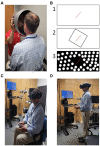Vestibular perceptual testing from lab to clinic: a review
- PMID: 37859653
- PMCID: PMC10583719
- DOI: 10.3389/fneur.2023.1265889
Vestibular perceptual testing from lab to clinic: a review
Abstract
Not all dizziness presents as vertigo, suggesting other perceptual symptoms for individuals with vestibular disease. These non-specific perceptual complaints of dizziness have led to a recent resurgence in literature examining vestibular perceptual testing with the aim to enhance clinical diagnostics and therapeutics. Recent evidence supports incorporating rehabilitation methods to retrain vestibular perception. This review describes the current field of vestibular perceptual testing from scientific laboratory techniques that may not be clinic friendly to some low-tech options that may be more clinic friendly. Limitations are highlighted suggesting directions for additional research.
Keywords: cognition; navigation; perception; spatial orientation; vestibular.
Copyright © 2023 Grove, Klatt, Wagner and Anson.
Conflict of interest statement
The authors declare that the research was conducted in the absence of any commercial or financial relationships that could be construed as a potential conflict of interest.
Figures




References
Publication types
Grants and funding
LinkOut - more resources
Full Text Sources
Miscellaneous

